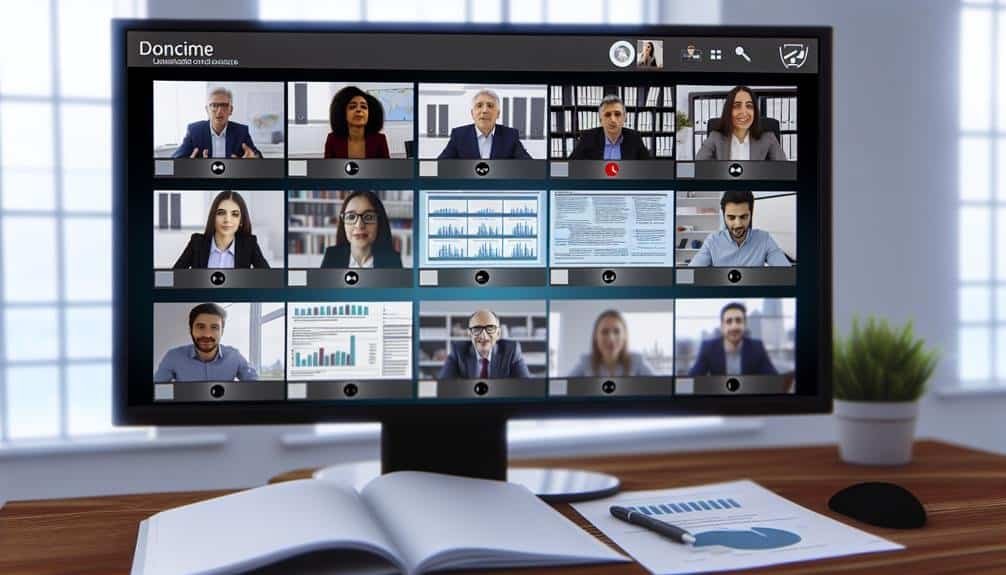Best Practices for Virtual Meetings and Web Conferences
In today's fast-paced and interconnected business world, virtual meetings and web conferences have become essential tools for collaboration and communication. With the rise of remote work and global teams, mastering the art of virtual meetings is crucial for maintaining productivity and fostering effective communication.
However, ensuring the success of these virtual interactions requires a thoughtful approach and adherence to best practices. From setting clear objectives to overcoming technical challenges, there are key strategies that can elevate the effectiveness of virtual meetings.
Understanding and implementing these best practices is not only beneficial for the smooth running of virtual meetings but also for building stronger connections with remote team members and clients.
Key Takeaways
- Setting clear objectives and communicating them to all attendees beforehand
- Selecting the right technology with user-friendly interface and recording capabilities
- Establishing meeting etiquette with guidelines for muting, active listening, and punctuality
- Engaging remote participants through interactive icebreakers, polls, breakout rooms, and fostering collaboration
Setting Clear Objectives
When preparing for virtual meetings and web conferences, it is essential to establish clear objectives to ensure the gathering is focused and productive. Establishing goals for the meeting or conference provides a clear direction for all participants, helping to avoid tangents and irrelevant discussions. Clear objectives also enable attendees to prepare adequately and contribute meaningfully to the discussion.
Additionally, communication strategies should be aligned with these objectives to ensure that the messages conveyed during the meeting are consistent with the goals set. This can involve using communication tools that facilitate the achievement of meeting objectives, such as setting agendas, providing pre-meeting materials, and using visual aids to enhance understanding.
In establishing goals for virtual meetings and web conferences, it is crucial to consider the desired outcomes and the steps needed to achieve them. This can involve setting specific targets for decision-making, problem-solving, or ideation, and communicating these targets to all attendees beforehand. By doing so, the meeting can be structured to focus on these objectives, making the most of everyone's time and expertise.
Effective communication strategies can then be employed to ensure that all participants are aware of the objectives and can contribute to their achievement.
Selecting the Right Technology
Selecting the appropriate technology for virtual meetings and web conferences is a critical decision that directly impacts the success and efficiency of the gathering. When choosing the right technology for virtual meetings and web conferences, it is crucial to consider various factors to ensure a seamless and productive experience. Here are some key considerations:
- Technology compatibility: Ensure that the chosen technology is compatible with the devices and operating systems that participants will be using. Compatibility issues can disrupt the meeting flow and create frustration among participants.
- Virtual platform features: Look for virtual platforms that offer a range of features to support the objectives of the meeting, such as screen sharing, interactive whiteboards, polling, breakout rooms, and recording capabilities. These features can enhance engagement and collaboration among participants.
- Security measures: Prioritize the security of the virtual meeting by selecting a technology solution that offers robust security features, such as end-to-end encryption, secure user authentication, and data protection protocols.
- User-friendly interface: Choose a technology solution with an intuitive and user-friendly interface to minimize the learning curve for participants and ensure smooth navigation during the meeting. A complex interface can lead to confusion and distractions, impacting the overall effectiveness of the gathering.
Establishing Meeting Etiquette
When conducting virtual meetings and web conferences, it is crucial to establish clear meeting etiquette to ensure smooth and productive interactions.
Points such as muting when not speaking and staying engaged throughout the discussion are essential for maintaining a professional and efficient virtual meeting environment.
Additionally, timely participation from all attendees is vital to maximize the effectiveness of the meeting.
Mute and Stay Engaged
To ensure an effective and productive virtual meeting or web conference, it is crucial to establish clear etiquette guidelines regarding muting and staying engaged. When it comes to muting and staying engaged during virtual meetings, it is important to follow best practices to maintain professionalism and attentiveness. Here are some key points to consider:
- Mute When Not Speaking: Encourage all participants to mute their microphones when they are not speaking to minimize background noise.
- Use Active Listening: Encourage active listening by nodding or using verbal cues to show attentiveness, even when not speaking.
- Engage Through Video: Encourage the use of video conferencing to enhance engagement and non-verbal communication.
- Participate Actively: Encourage all participants to actively participate by asking questions, giving feedback, and contributing to the discussion.
Timely Participation
Establishing punctuality as a fundamental aspect of meeting etiquette is essential for ensuring efficient and respectful virtual gatherings. Timely participation involves actively listening to others and providing prompt responses when engaging in virtual meetings and web conferences. It demonstrates respect for other participants' time and contributes to the overall productivity of the meeting.
Active listening in virtual meetings entails giving full attention to the speaker, processing the information, and responding appropriately. Prompt responses, on the other hand, involve reacting quickly to questions, comments, or requests, thus maintaining the flow and momentum of the discussion.
Engaging Remote Participants
To ensure active participation from remote attendees, interactive icebreakers, such as fun introductions or team-building exercises, can help set a positive and engaging tone for the meeting.
Using polls for feedback at key points during the virtual meeting can also provide an opportunity for participants to share their thoughts and contribute to the discussion.
Additionally, employing active participation techniques, such as breakout rooms for small group discussions or Q&A sessions, can further enhance engagement and collaboration among remote participants.
Interactive Icebreakers
Engaging remote participants through interactive icebreakers is essential for fostering a sense of connection and participation in virtual meetings and web conferences. Interactive icebreakers can help break the ice, encourage active participation, and create a more engaging and enjoyable virtual environment.
Here are some effective icebreaker ideas to engage remote participants:
- Virtual games such as trivia quizzes or Pictionary
- Group activities like sharing interesting facts about themselves
- Polls or surveys to gather opinions and preferences
- Quick brainstorming sessions on a fun topic
Polls for Feedback
A practical way to gather valuable insights and feedback from remote participants is by utilizing polls during virtual meetings and web conferences. Using interactive, engaging polls for feedback can ensure active participation and provide real-time input from attendees. Incorporating polls into virtual meetings allows presenters to gauge participant understanding, gather opinions, and make data-driven decisions. Ensuring active participation through polling and feedback techniques is essential for keeping remote attendees engaged and invested in the meeting or conference. Below is a table outlining some effective polling and feedback techniques:
| Polling and Feedback Techniques | Benefits |
|---|---|
| Multiple-choice polls | Quick data collection |
| Open-text polls | In-depth feedback |
| Rating scale polls | Measure sentiment |
| Anonymous polls | Encourage honest responses |
| Real-time results sharing | Enhance engagement |
Active Participation Techniques
Implementing interactive activities and fostering two-way communication are crucial for achieving active participation and engagement among remote participants during virtual meetings and web conferences. To ensure active participation, consider incorporating the following techniques:
- Brainstorming Activities: Encourage remote participants to share their ideas and solutions by using virtual whiteboards or collaborative documents.
- Group Discussions: Break participants into smaller groups to discuss specific topics or challenges, then reconvene to share insights with the larger group.
- Interactive Polls: Use real-time polling tools to gather opinions and feedback on various meeting topics.
- Q&A Sessions: Allocate time for remote participants to ask questions and provide responses, fostering a collaborative environment.
These techniques can help create an inclusive and engaging virtual meeting environment, promoting active participation and valuable contributions from all participants.
Managing Time Effectively
To effectively manage time during virtual meetings and web conferences, it is essential to establish a clear agenda and adhere to predetermined timeframes for each agenda item. Time management is crucial for virtual productivity, ensuring that meetings are efficient and productive. By setting clear objectives for each agenda item and allocating specific timeframes, participants are more likely to stay focused and engaged, leading to better outcomes.
| Time Allocation | Agenda Item | Responsible Person |
|---|---|---|
| 5 mins | Welcome and Introductions | Meeting Facilitator |
| 15 mins | Presentation of Key Points | Team Lead |
| 10 mins | Q&A Session | Moderator |
| 5 mins | Summary and Next Steps | Project Manager |
The table above illustrates an example of how time can be allocated for different agenda items. By following the allocated timeframes, participants can ensure that discussions are concise and relevant. Additionally, using time-tracking tools and setting time limits for individual contributions can further aid in managing time effectively during virtual meetings and web conferences.
Overcoming Technical Challenges
Given the critical role of effective time management in virtual meetings and web conferences, the successful navigation of technical challenges is paramount to ensuring seamless and productive interactions. When facing technical issues during virtual meetings, it's essential to have a systematic approach to troubleshooting in order to minimize disruptions and maintain the flow of the discussion.
Here are some best practices for overcoming technical challenges:
- Troubleshooting Audio Issues: Start by checking the microphone and speaker settings on your device. If the issue persists, consider using a different audio device or restarting the meeting application.
- Troubleshooting Video Issues: If the video feed is unclear or frozen, check your internet connection first. If the problem persists, try disabling the video and re-enabling it, or switch to a different camera if available.
- Connectivity Problems: If you experience connectivity issues, try moving closer to the Wi-Fi router or using a wired connection. It's also helpful to close any unnecessary applications or browser tabs that may be consuming bandwidth.
- Screen Sharing Issues: If encountering problems with screen sharing, ensure that the correct window or application is selected for sharing. Additionally, restart the screen sharing function or the entire meeting application if needed.
Evaluating Meeting Effectiveness
The assessment of meeting effectiveness is crucial for optimizing productivity and maximizing the value of virtual interactions. Measuring outcomes and improving engagement are key factors in evaluating the success of virtual meetings and web conferences.
To measure outcomes, it is essential to establish clear meeting objectives and desired results beforehand. This can include specific deliverables, decisions made, or actions agreed upon during the meeting. Post-meeting surveys or feedback forms can also be used to gather insights into the perceived effectiveness of the meeting. Additionally, tracking key performance indicators such as attendance, participation levels, and follow-up actions can provide valuable data for evaluation.
Improving engagement is another vital aspect of evaluating meeting effectiveness. This involves assessing the level of active participation, collaboration, and contribution from attendees. Tools such as polling, interactive Q&A sessions, and breakout discussions can be utilized to enhance engagement during virtual meetings.
Evaluating meeting effectiveness allows for identifying strengths and areas for improvement, ultimately leading to more impactful and successful virtual interactions.
Conclusion
In conclusion, implementing best practices for virtual meetings and web conferences is vital for successful and productive remote collaboration.
By setting clear objectives, organizations can ensure that the purpose of the meeting is well-defined and that participants are aligned on the desired outcomes.
Selecting the right technology is crucial to ensure smooth communication and collaboration. It is important to choose a platform that is reliable, user-friendly, and supports the specific needs of the meeting.
Establishing meeting etiquette is essential for creating a respectful and inclusive environment. This includes guidelines for participation, muting when not speaking, and using video whenever possible to enhance engagement.
Engaging remote participants is key to keeping them actively involved and invested in the meeting. This can be achieved through interactive activities, asking for input and feedback, and providing opportunities for remote participants to share their perspectives.
Managing time effectively ensures that meetings stay on track and do not run longer than necessary. This includes setting an agenda, allocating time for each agenda item, and staying disciplined in sticking to the schedule.
Overcoming technical challenges is inevitable in virtual meetings, but having contingency plans and troubleshooting strategies in place can minimize disruptions and keep the meeting running smoothly.
Evaluating meeting effectiveness allows organizations to continuously improve and refine their virtual meeting practices. This can be done through post-meeting surveys, feedback sessions, or analyzing meeting metrics such as attendance and participant engagement.
Remember, 'the proof is in the pudding' – implementing these best practices will lead to positive outcomes and improved virtual meeting experiences.







